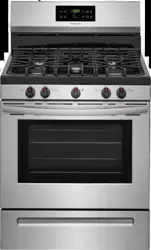Documents: Go to download!
User Manual
- User Manual - (English)
- Dimension Guide - (English)
- Warranty - (English)
- Installation Instruction - (English)
- Installation Instruction - (Spanish)
- IMPORTANT SAFETY INSTRUCTIONS
- COOKING RECOMMENDATIONS
- BEFORE SETTING SURFACE CONTROLS
- SETTING SURFACE CONTROLS
- BEFORE SETTING OVEN CONTROLS
- SETTING OVEN CONTROLS
- CARE AND CLEANING
- BEFORE YOU CALL
Table of contents
User Manual Gas Range
IMPORTANT SAFETY INSTRUCTIONS
Read all instructions before using this appliance.
This manual contains important safety symbols and instructions. Please pay attention to these symbols and follow all instructions given.
Do not attempt to install or operate your appliance until you have read the safety precautions in this manual. Safety items throughout this manual are labeled with a WARNING or CAUTION statement based on the risk type.
Warnings and important instructions appearing in this guide are not meant to cover all possible conditions and situations that may occur.
Common sense. caution. and care must be exercised with installation. maintaining. or operating your appliance.
DEFINITION :This is the safety alert symbol. It is used to alert you to potential personal injury hazards.Obey all safety messages that follow this symbol to avoid possible injury or death.
WARNING : Indicates a potentially hazardous situation which. if not avoided. may result in death or serious injury.
CAUTION : Indicates a potentially hazardous situation which. if not avoided. may result in minor or moderate injury.
IMPORTANT : Indicates installation, operation, maintenance, or valuable information that is not hazard-related.
NOTE : Indicates a short, informal reference – something is written down to assist the memory or for future reference.
If the information in this manual is not followed exactly. a fire or explosion may result causing property damage. personal injury or death.
FOR YOUR SAFETY: Do not store or use gasoline or other flammable vapors and liquids in the vicinity of this or any other appli ance.
WHAT TO DO IF YOU SMELL GAS:
- Do not try to light any appliance.
- Do not touch any electrical switch; do not use any phone in your building.
- Immediately call your gas supplier from a neighbor's phone. Follow the gas supplier's instructions.
- If you cannot reach your gas supplier. call the fire department.
- Installation and service must be performed by a qualified installer. servicer. or the gas supplier.
IMPORTANT INSTRUCTIONS FOR UNPACKING AND INSTALLATION
IMPORTANT - Read and follow the below instructions and precautions for unpacking. installing. and servicing your appliance:
Remove all tape and packaging before using the appliance. Destroy the carton and plastic bags after unpacking the appliance. Never allow children to play with packaging material. Do not remove the wiring label and other literature attached to the appliance. Do not remove model/ serial number plate.
Cold temperatures can damage electronic control. When using this appliance for the first time. or when the appliance has not been used for an extended period of time. be sure the appliance has been in temperatures above 32ºF (0ºC) for at least 3 hours before turning on the power to the appliance.
Never modify or alter the construction of the appliance by removing the leveling legs. panels. wire covers. anti-tip brackets/screws. or any other part of the appliance.
Be sure to have an appropriate foam-type fire extinguisher available. visible. and easily accessible located near the appliance.
Warning : Air curtains or other overhead range hoods which operate that operate by blowing a downward airflow onto a range or cooktop. shall not be used in conjunction with gas ranges or cooktops other than when the range or cooktop and hood have been designed. tested. and listed by an independent test laboratory for use in combination with each other.
GROUNDING INSTRUCTIONS
Proper Installation—Be sure your appliance is properly installed and grounded by a qualified technician. In the United States. install in accordance with the National Fuel Gas Code ANSI Z223.1/NPFA No. 54. the latest edition and National Electrical Code NFPA No. 70 latest edition. and local electrical code requirements. In Canada. install in accordance with CAN/CGA B149.1 and CAN/CGA B149.2 and CSA Standard C22.1.
Canadian Electrical code. Part 1-latest editions and local electrical code requirements. Install only per installation instructions provided in the literature package for this appliance.
For personal safety. this appliance must be properly grounded. For maximum safety. the power cord must be securely connected to an electrical outlet or junction box that is the correct voltage. is correctly polarized and properly grounded. and protected by a circuit breaker in accordance with local codes.
It is the personal responsibility of the consumer to have the appropriate outlet or junction box with the correct. properly grounded wall receptacle installed by a qualified electrician. It is the responsibility and obligation of the consumer to contact a qualified installer to assure that the electrical installation is adequate and is in conformance with all local codes and ordinances.
This appliance is equipped with a 3-prong grounding plug for your protection against shock hazards and should be plugged directly into a properly grounded receptacle. Do not cut or remove the grounding prong from this plug.
For personal safety. the appliance must be properly grounded. For maximum safety. the power cord must be plugged into an electrical outlet that is correctly polarized and properly grounded.
If a 2-prong wall receptacle is the only available outlet. it is the personal responsibility of the consumer to have it replaced with a properly grounded 3-prong wall receptacle. installed by a qualified technician.

Conversion to (L.P.) Gas
This appliance allows for conversion to Liquefied Petroleum (L.P.) Gas.
If L.P. conversion is needed, contact your local L.P. Gas provider for assistance.
WARNING : Avoid fire hazard or electrical shock. Failure to follow this warning may cause serious injury. fire. or death.
Avoid fire hazard or electrical shock. Do not use an adapter plug. use an extension cord. or remove grounding prong from the power cord.
Failure to follow this warning may cause serious injury, fire, or death.
Personal injury or death from electrical shock may occur if the conversion to L.P, gas is not made by a qualified installer or electrician. Any additions, changes or conversions required in order for this appliance to satisfactorily meet the application needs must be made by a qualified technician.
See the installation instructions packaged with this appliance for complete installation and grounding instructions.
IMPORTANT INSTRUCTIONS FOR USING THE APPLIANCE
Storage In or On Appliance—Flammable materials should not be stored in an oven or microwave, near surface burners or elements, or in the storage or warmer drawer (if equipped). This includes paper, plastic, and cloth items. such as cookbooks, plastic ware, and towels, as well as flammable liquids. Do not store explosives, such as aerosol cans, on or near the appliance.
Do not leave children alone - Children should not be left alone or unattended in the area where appliance is in use. They should never be allowed to sit or stand on any part of the appliance. including the storage drawer. lower broiler drawer. warmer drawer, or lower double oven.
Do not store items of interest to children in the cabinets above the appliance or on the back guards of ranges. Children climbing on or near the appliance to reach items could be seriously injured.
Do not allow children to climb or play around the appliance. The weight of a child on an open over door may cause the appliance to tip. resulting in serious burns or other injury. An open drawer when hot may cause burns.
Stepping, leaning, or sitting on the door or drawers of this appliance can result in serious injuries and also cause damage to the appli ance.
Never cover any slots, holes, or passages in the oven bottom or cover an entire oven rack with any materials, such as aluminum foil or after market oven liners. Aluminum foil and other liners may trap heat. causing a fire hazard.
Do not use oven or warmer drawer (if equipped) for storage.
Never use your appliance as a space heater to heat or warm the room. Doing so may result in carbon monoxide poisoning and overheating of the appliance.
CAUTION : When heating fat or grease, watch it closely.Grease may catch fire if it becomes too hot.
Do not use water or flour on grease fires. Smother fire or flame or use a dry chemical or foam-type extinguisher. Cover the fire with a pan lid or use baking soda.
Use dry potholders. Moist or damp potholders on hot surfaces may result in burns from steam. Do not let potholders touch hot cooking areas. Do not use towels or other bulky cloths. Do not heat unopened food containers - Build up of pressure may cause container to burst and result in injury.
Wear proper apparel - Loose-fitting or hanging garments should never be worn while using the appliance. Do not let clothing or other flammable materials contact hot surfaces.
IMPORTANT INSTRUCTIONS FOR USING YOUR GAS COOKTOP
Know which knob or key controls each surface heating area. Place cookware with food on the cooking area before turning it on. Turn the cooking area off before removing the cookware.
Use proper pan size. This appliance is equipped with one or more surface units of different sizes.
Select cookware with flat bottoms that match the surface unit heating element. The use of undersized cookware may expose a portion of the flame to direct contact and may result in the ignition of clothing or other items. Using the proper cookware on the cooking areas will improve efficiency.
Always turn the knob to the full LITE position when igniting top burners. Visually check that burner has lit. Then adjust the flame so it does not extend beyond the edge of the utensil.
To reduce the risk of burns, ignition of flammable materials, and spillage due to unintentional contact with the utensil, the handle of the utensil should be positioned so that it is turned inward, and does not extend over adjacent surface burners.
Never leave surface burners unattended at high heat settings — Boil overs cause smoking and greasy spill overs that may ignite, or a pan that has boiled dry may melt.
Glazed cooking utensils — Only certain types of glass, glass/ceramic, ceramic, earthenware, or other glazed utensils are suitable for cook top service without breaking due to the sudden change in temperature. Check the manufacturer’s recommendations for cook top use.
When you are flaming foods under a ventilating hood, turn the fan on.
IMPORTANT INSTRUCTIONS FOR USING YOUR OVEN
Protective liners—Do not use aluminum foil, aftermarket oven liners, or any other materials or devices to line oven bottom, oven racks, or any other part of the appliance. Only use aluminum as recommended for baking, such as lining cookware or as a cover placed on food. Any other use of protective liners or aluminum foil may result in a risk of electric shock or fire or a short circuit.
Use care when opening oven door, lower oven door, or warmer drawer (some models). Stand to the side of the appliance when opening the door of a hot oven. Let hot air or steam escape before you remove or replace food in the oven. Keep oven vent ducts unobstructed. Touching surfaces in this area when the oven is on may cause severe burns. Do not place plastic or heatsensitive items on or near the oven vent. These items can melt or ignite. Placement of oven racks - Always place oven racks in desired location while oven is cool. If rack must be moved while oven is hot, do not let potholder contact hot burner or element in oven. Use potholders and grasp the rack with both hands to reposition. Remove all cookware and utensils before moving the rack. Do not use a broiler pan without its insert. Broiler pans and inserts allow dripping fat to drain away from the high heat of the broiler. Do not cover the broiler insert with aluminum foil; exposed fat and grease could ignite. Do not cook food on the oven bottom. Always cook in proper cookware and always use the oven racks.
IMPORTANT INSTRUCTIONS FOR CLEANING YOUR APPLIANCE
Clean the appliance regularly to keep all parts free of grease that could catch fire. Do not allow grease to accumulate. Greasy deposits in the fan could catch fire.
Always follow the manufacturer’s recommended directions for use of kitchen cleaners and aerosols. Be aware that excess residue from cleaners and aerosols may ignite causing damage and injury. Clean ventilating hoods frequently - Grease should not be allowed to accumulate on hood or filter. Follow the manufacturer’s instructions for cleaning vent hoods.
IMPORTANT INSTRUCTIONS FOR SELF CLEANING OVENS
Do not clean the oven door gasket. The door gasket is essential for a good seal. Care should be taken not to rub, damage, or move the gasket. Do not use oven cleaners. No commercial oven cleaner or oven liner protective coating of any kind should be used in or around any part of the appliance. Use the self clean cycle to clean only the parts listed in this manual. Before using self clean, remove the broiler pan, any food, utensils, and cookware from the oven, storage drawer or warming drawer (if equipped). Remove oven racks unless otherwise instructed. Some birds are extremely sensitive to the fumes given off during the self clean cycle of any oven. Move birds to another well-ventilated room.
IMPORTANT INSTRUCTIONS FOR SERVICE AND MAINTENANCE
Do not repair or replace any part of the appliance unless specifically recommended in the manuals. All other servicing should be done only by a qualified technician. This reduces the risk of personal injury and damage to the appliance. Always contact your dealer, distributor, service agent, or manufacturer about problems or conditions you do not understand. Ask your dealer to recommend a qualified technician and an authorized repair service. Know how to disconnect the power to the appliance at the circuit breaker or fuse box in case of an emergency. Remove the oven door from any unused oven if it is to be stored or discarded. Do not touch a hot oven light bulb with a damp cloth. Doing so could cause the bulb to break. Handle halogen lights (if equipped) with paper towels or soft gloves. Disconnect the appliance or shut off the power to the appliance before removing and replacing the bulb.
Important Safety Notice - The California Safe Drinking Water and Toxic Enforcement Act requires the governor of California to publish a list of substances known to cause cancer, birth defects, or other reproductive harms, and requires businesses to warn customers of potential exposures to such substances.
COOKING RECOMMENDATIONS
Bakeware
The material of bakeware affects how evenly and quickly it transfers heat from the pan to the food
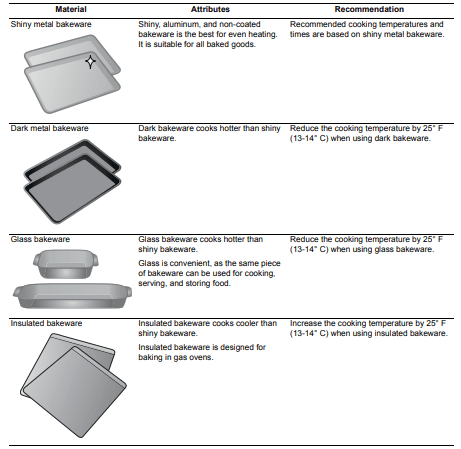
Cooking Conditions
Conditions in your kitchen can affect the performance of your appliance when cooking food.
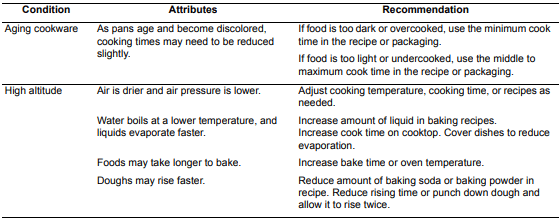
Cooking Results
Small adjustments may fix a problem with food not being as done as you like or more done than you like.
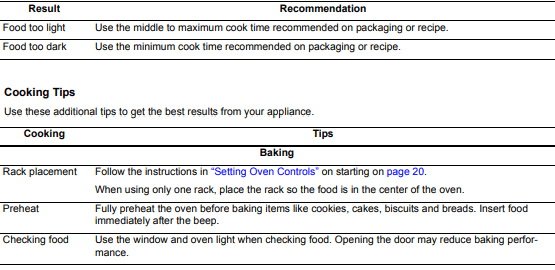

BEFORE SETTING SURFACE CONTROLS
Assembly of the burner caps
Make sure that all of the surface burner caps and surface burner grates are installed correctly and at the correct locations
1. Remove all packing material from the cooktop area.
2. Make sure burner caps are properly placed on the surface burners.
3. Unpack the burner grates and position them on the cooktop.
4. Discard all packing material.
On round-style burners, the burner cap lip (Figure 1) should fit snugly into the center of the burner head and rest level. Refer to Figure 2 for correct and incorrect burner cap placement.
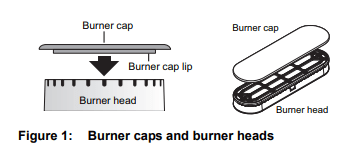

Once in place, you may check the fit by gently sliding the burner cap from side to side (Figure 3) to be sure it is centered and firmly seated. When the burner cap lip makes contact inside the center of the burner head you will be able to hear the burner cap click

Install burner grates
To install burner grates, place the grates flat-side down and align them into the cooktop recess.
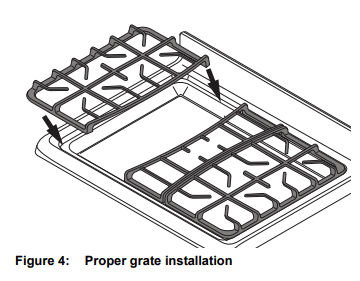
Using Proper Cookware
The size and type of cookware used will influence the heat setting needed for best cooking results. Be sure to follow the recommendations for using proper cookware as illustrated in Figure 5 and Figure 6.
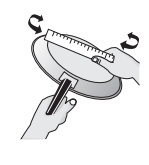
Figure 5: Testing cookware
Check for flatness by rotating a ruler across the bottom of the cookware (See Figure 5). Cookware should have flat bottoms that make good contact with the entire surface heating element (See Figure 6).

Cookware Material Types
The cookware material determines how evenly and quickly heat is transferred from the surface burner to the pan bottom. The most popular materials available are:
- Aluminum - Excellent heat conductor. Some types of food will cause it to darken (Anodized aluminum cookware resists staining and pitting).
- Copper - Excellent heat conductor but discolors easily (See Aluminum).
- Stainless - Slow heat conductor with uneven cooking results. Is durable, easy to clean and resists staining.
- Cast Iron - A slow heat conductor that retains heat very well. Cooks evenly once cooking temperature is reached.
- Porcelain-enamel on metal - Heating characteristics will vary depending on base material.
- Glass - Slow heat conductor.
Gas surface burner types
The cooktop is equipped with gas surface burners with different BTU ratings. The ability to heat food quickly and in large amounts increases as the burner size increases.
- Small burners are best used for low-flame heating of small amounts of food.
- Standard burners can be used for most surface cooking needs.
- The largest burner is best used for bringing large quantities of liquid rapidly up to temperature or when preparing larger quantities of food. The large burner is located at the right front position on the cooktop.
Regardless of size, always select cookware that is suitable for the amount and type of food being prepared. Select a burner and set the flame size appropriately for the pan. Never allow flames to extend beyond the outer edge of the pan.
SETTING SURFACE CONTROLS
Setting surface controls
The ability to heat food quickly and in large volumes increases as the burner size increases. Your gas appliance may be equipped with many different sized surface burners. It is important to select cookware that is suitable for the amount and type of food being prepared. Select a burner and flame size appropriate for the cookware size.
- The standard size burner or burners may be used for most surface cooking needs.
- Small burners are best used for low-flame heating of small amounts of food.
- Large burners are best for bringing large quantities of liquid to temperature or heating larger quantities of food.
Setting a surface burner:
1. Place cooking utensil on center of surface burner grate. Be sure the cooking utensil rests stable on the burner grate.
2. Push the burner’s surface control knob in and turn counterclockwise out of the OFF position (Figure 7).
3. Release the surface control knob and rotate to the LITE position  . Visually check that the burner has a steady gas flame.
. Visually check that the burner has a steady gas flame.
4. Once the surface burner has a flame, push the surface control knob in and turn counterclockwise to the desired flame size setting. Adjust the flame as needed using the knob markings.
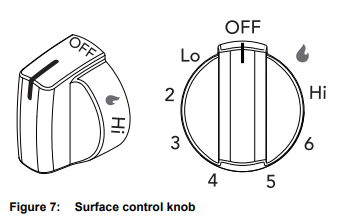
Set proper burner flame size
The color of the flame is the key to proper burner adjustment. A good flame is clear, blue and hardly visible in a well-lighted room. Each cone of flame should be steady and sharp. Adjust or clean the burner if flame is yellow-orange.
For most cooking: start on the highest setting and then turn to a lower setting to complete the process. Use the recommendations below as a guide for determining proper flame size for various types of cooking (Figure 9).
For deep fat frying: use a thermometer and adjust the surface knob accordingly. If the fat is too cool, the food will absorb the fat and be greasy. If the fat is too hot, the food will brown so quickly that the center will be under-cooked. Do not attempt to deep fat fry too much food at once as the food will neither brown nor cook properly
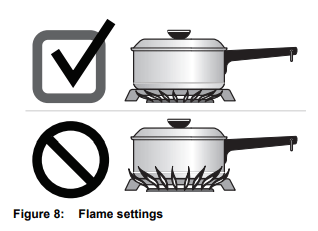
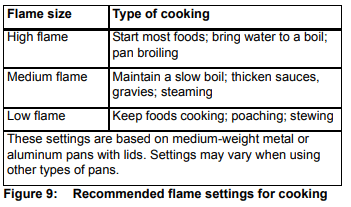
Cooking with a griddle (some models)
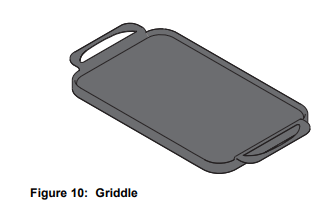
The griddle is a versatile accessory that is perfect for cooking foods that require large flat surfaces such as pancakes, French toast, grilled sandwiches, bacon, and also for cooking different foods at the same time. After use, let the griddle cool before washing. Hand wash with hot soapy water. Do not soak. Dry thoroughly. Do not put a griddle in a dishwasher. If you would like to purchase a griddle, you can order one from Frigidaire.com.
Using the griddle:
Place the griddle securely on top of the burner grates. Preheat the griddle for 5 minutes on medium to medium low setting. Slow preheat ensures even heat distribution during the cooking process. DO NOT preheat the griddle on HI setting. Preheating on HI may warp the griddle and prevent even heat distribution.
Home Canning
Be sure to read and observe all the following points when home canning with your appliance. Check with the USDA (United States Department of Agriculture) Web site and be sure to read all the information they have available as well as follow their recommendations for home canning procedures.
- Use only a completely flat bottom canner with no ridges that radiate from the bottom center when home canning. Heat is spread more evenly when the bottom surface is flat. Use a straight-edge to check canner bottom.
- Make sure the diameter of the canner does not exceed 1 inch beyond the surface element markings or burner.
- It is recommended to use smaller diameter canners on electric coil and ceramic glass cooktops and to center canners on the burner grates.
- Start with hot tap water to bring water to boil more quickly.
- Use the highest heat seating when first bringing the water to a boil. Once boiling is achieved, reduce heat to lowest possible setting to maintain that boil.
- Use tested recipes and follow instructions carefully. Check with your local Cooperative Agricultural Extension Service or a manufacturer of glass jars for the latest canning information.
- It is best to can small amounts and light loads.
- Do not leave water bath or pressure canners on high heat for an extended amount of time.
BEFORE SETTING OVEN CONTROLS
Oven Vent Location
The oven is vented as shown below. When the oven is on, warm air is released through the vent. This venting is necessary for proper air circulation in the oven and good baking results. Do not block oven vent. Never close off the openings with aluminium foil or any other material. Steam or moisture may appear near the oven vent. This is normal.
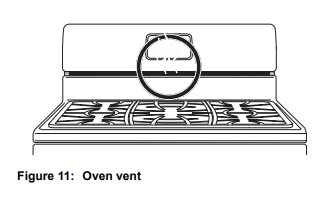
Types of oven racks

- Flat oven racks may be used for most cooking needs and may be placed in most oven rack positions.
- The offset oven rack (some models) provides additional step down positions from the standard flat rack design. The offset design positions the base of the rack about ½ of a rack position lower than the flat rack and may be used in most oven rack positions. To maximize oven cooking space, place the bottom oven rack in the lowest rack position for baking or roasting large cuts of meat
Removing, replacing, and arranging flat or offset oven racks
Always arrange the oven racks when the oven is cool.
To remove - Pull the oven rack straight forward until it reaches the stop position. Lift up front of oven rack slightly and slide out.
To replace - Place the oven rack on the rack guides on both sides of oven walls. Tilt the front of oven rack upward slightly and slide the oven rack back into place. Be sure oven racks are level before using.
SETTING OVEN CONTROLS
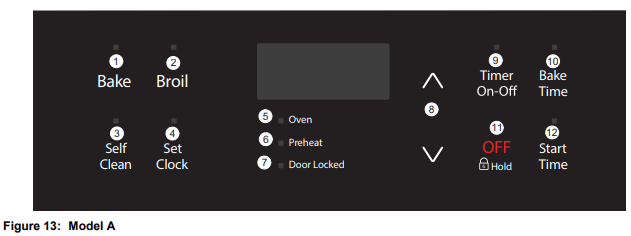
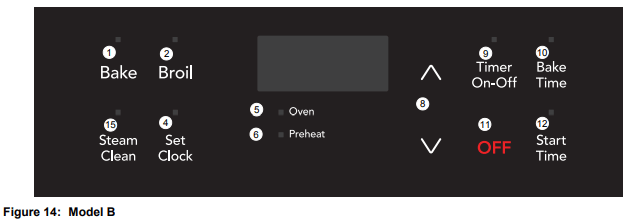
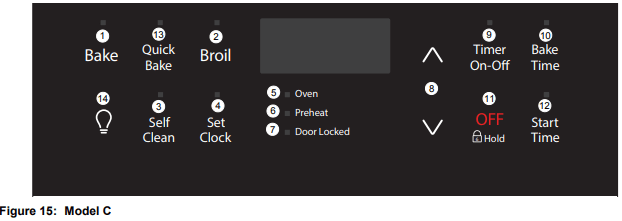
Oven Control Features
1. Bake - Use to select Bake feature.
2. Broil - Use to set Broil feature.
3. Self Clean - (some models) Use to with arrow keys to set self clean cycle of 2 or 3 hours.
4. Set Clock - Use with arrow keys to set the time of day.
5. Oven on indicator light - The oven light will glow each time the oven turns on to maintain the set oven temperature.
6. Preheat light - The preheat light will glow when the oven is preheating or if the desired temperature is reset higher than the actual oven temperature.
7. Door locked - The door locked light will flash when the oven door locks and unlocks, when the oven door lockout is active, or when the self clean cycle feature is active.
8. Up and Down arrows - Use with the feature or function keys to set oven temperature, Bake Time, Start Time, clean time, and setting or adjusting the clock and minute timer
9. Timer on-off - Use to set or cancel the minute timer. The minute timer does not start or stop any cooking function. Timer on-off is used to set the continuous bake function.
10. Bake Time - Enters the length of baking time desired.
11. OFF - Use to clear any feature previously entered except the time of day and minute timer. Also use OFF to activate oven lockout feature. (some models)
12. Start Time - Use to set the desired start time for baking and self clean. May be used with Bake Time to program a delayed timed bake.
13. Quick Bake - Quick Bake uses a fan to circulate the oven's heat uniformly and continuously around the oven. This improved heat distribution allows for fast, even cooking and browning results.
14. Oven Light - Use to turn on internal light when checking on food. Also will turn on when the oven door is open.
15. Steam Clean (some models) - The Steam Clean feature offers a chemical free and time saving method to assist in the routine cleaning of small and light soils.
Table 1: Minimum and maximum control settings

Setting the Clock
When the appliance is first plugged in or when the power supply to the appliance has been interrupted, the display will flash 12:00. It is recommended to always set the clock for the correct time of day before using the appliance.
To set the clock:
1. Press clock once (do not hold clock key down).
2. Within 5 seconds, press and hold or
or until the correct time of day appears in the display.
until the correct time of day appears in the display.
Temperature display (Fahrenheit/Celsius)
The electronic oven control is set to operate in Fahrenheit (°F) at the factory. The oven may be programmed for any temperature from 170°F to 550°F (77°C to 288°C).
To change the temperature to Celsius (°C) or from °C to °F:
1. Press broil. — — appears in the display.
2. Press and hold until HI appears in the display.
until HI appears in the display.
3. Press and hold broil until °F or °C appears in the display.
4. Press or
or  to change °F to °C or °C to °F. To accept the change, wait 6 seconds.
to change °F to °C or °C to °F. To accept the change, wait 6 seconds.
Continuous bake setting or 12-hour energy saving feature
The oven control has a built-in 12-hour energy saving feature that will shut off the oven if the oven is left on for more than 12 hours. The oven control can be programmed to override this feature for continuous baking.
To change the continuous bake setting:
1. Press and hold timer on-off for 6 seconds until a tone sounds. — — hr will appear in the display for continuous cooking. The current time of day will return to the display.
2. To cancel the continuous bake setting, press timer onoff and hold for 6 seconds until a tone sounds. 12 hr will appear in display indicating that the control has returned to the 12-hour energy saving feature.
Setting a silent control panel
When selecting a function, an audible tone is heard each time a key is pressed. If desired, the control can be programmed for silent operation.
To set the controls for silent operation:
1. Press and hold start time for 6 seconds. The control will beep once and release the key.
2. The controls are now set for silent operation.
To return to non-silent operation:
1. Press and hold start time again for 6 seconds until the control beeps once and release the key.
2. The control is now set for audible operation.
Setting oven lockout (models A and C)
The control can be programmed to lock the oven door and lockout the oven control keypad.
To set the oven lockout feature:
1. Press OFF and hold for 3 seconds. Loc will appear in display, the door locked indicator light will flash, and the motor driven door lock will begin to close. Allow about 15 seconds for the oven door to lock. Once the oven door is locked, the current time of day will appear in the display.
2. To cancel the Oven Lockout feature, press OFF and hold for 3 seconds. The control will unlock the oven door and resume normal operation.
Operating oven light
(Models A and B)
The interior oven light will automatically turn on when the oven door is opened. Press the oven light switch located on the upper left control panel to turn the interior oven light on and off whenever the oven door is closed. The interior oven light is located at the upper left rear wall of the oven interior. To change the interior oven light, see “Changing the oven light” in the Care & cleaning section.

Setting the minute timer
1. Press timer on-off.
2. Press to increase time in one-minute increments. Press and hold
to increase time in one-minute increments. Press and hold  to increase time in 10-minute increments. The timer can be set for any amount of time from 1 minute to 11 hours and 59 minutes.
to increase time in 10-minute increments. The timer can be set for any amount of time from 1 minute to 11 hours and 59 minutes.
3. When the set time ends, the timer will beep three times and will continue to beep three times every minute until timer on-off is pressed
To change the timer while it is in use:
While the timer is active and shows in the display, press and hold  or
or  to increase or decrease the time remaining.
to increase or decrease the time remaining.
To cancel the minute timer before the set time has run out:
- Press timer on-off once.
Setting Bake
The oven can be programmed to bake at any temperature from 170°F to 550°F (77°C to 288°C). The factory preset automatic bake temperature is 350°F (177°C).
Baking Tips
For best bake results:
- Fully preheat the oven before baking.
- When baking items like cookies, cakes, biscuits, and breads using a single rack place rack in position 4.
- When using any single rack for items like frozen pies, angel food cake, breads, and casseroles, use rack position 3.
- For best results when baking cakes using two oven racks, place racks in positions 3 and 5 (See Figure 17).
- When baking using two oven racks, position cookware as shown in Figure 16.
- Allow at least 2 inches (5 cm) of space between cookware for proper air circulation.

To set Bake:
1. Press Bake. — — — appears in the display.
2. Within 5 seconds, press or
or . The display will show 350°F (177°C). The temperature can then be adjusted in 5°F (1°C) increments.
. The display will show 350°F (177°C). The temperature can then be adjusted in 5°F (1°C) increments.
3. When a key is released, the oven will begin heating to the selected temperature. When the oven reaches the set temperature, the preheat indicator light will turn off and the control will beep three times.
4. To cancel the baking function, press OFF.
To change oven temperature after Bake has started:
1. Press Bake.
2. Press or
or to increase or decrease to a new temperature. The oven indicator light on the electronic display will turn on and off when using the bake feature and during preheat. This is normal and indicates that the oven is cycling to maintain the selected baking temperature. To cancel baking press OFF.
to increase or decrease to a new temperature. The oven indicator light on the electronic display will turn on and off when using the bake feature and during preheat. This is normal and indicates that the oven is cycling to maintain the selected baking temperature. To cancel baking press OFF.
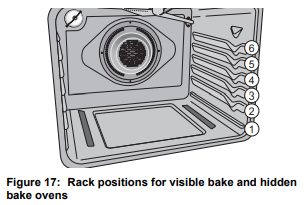
Quick Bake (Model B)
Quick Bake uses a fan to circulate the oven's heat uniformly and continuously around the oven. The fan will turn on 6 minutes after the oven is set. The oven may be programmed to Quick Bake at any temperature from 170°F to 550°F (77°C to 288°C). The factory preset Quick Bake temperature is 350°F (177°C).
Benefits of the Quick Bake feature:
- Most foods can be cooked faster and more evenly with Quick Bake.
- Multiple rack baking.
Baking Tips
- Fully preheat the oven when baking foods such as cookies, biscuits and breads.
- Reduce oven temperature 25°F from recipe's recommended oven temperature. Follow the remainder of the recipe's instructions using the minimum recommended cook time.
- When using 2 oven racks place racks in positions 3 and 5 for and position cookware as shown in Figure 18.
- For single rack baking use rack position 4.
Roasting Tips
- Preheating is not necessary when roasting foods using Quick Bake. Do not cover foods when dry roasting.
- For Turkey, roasts and hams, use rack position 2.
- For small cuts of meat or poultry use rack positions 2 or 3
Setting Quick Bake
To set Quick Bake:
1. Press Quick Bake. — — — ° appears in the display.
2. Within 5 seconds, press or
or  . The display will show 350°F (177°C). The temperature can then be adjusted in 5°F (1°C) increments using the up or down arrow keys.
. The display will show 350°F (177°C). The temperature can then be adjusted in 5°F (1°C) increments using the up or down arrow keys.
3. When a key is released, the oven will begin heating to the selected temperature.
4. When the oven reaches the set temperature, the preheat indicator light will turn off and the control will beep three times.
5. To cancel Quick Bake, press OFF.
To change oven temperature after Quick Bake has started:
1. Press Quick Bake.
2. Press  or
or  to increase or decrease to a new temperature. The oven indicator light on the electronic display will turn on and off when using the bake feature and during preheat. This is normal and indicates that the oven is cycling to maintain the selected baking temperature.
to increase or decrease to a new temperature. The oven indicator light on the electronic display will turn on and off when using the bake feature and during preheat. This is normal and indicates that the oven is cycling to maintain the selected baking temperature.
3. To cancel baking press OFF
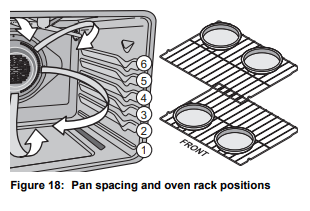
Setting Bake Time
The Bake Time key sets the amount of time needed for baking. The oven will turn on immediately and stop automatically after the set bake time ends.
To program the oven to begin baking immediately and to shut off automatically (timed bake):
1. Be sure the clock is set to the correct time of day.
2. Place the food in the oven.
3. Press Bake. — — — ° appears in the display.
4. Within 5 seconds, press or
or . The display will show 350°F (177°C). The temperature can then be adjusted in 5°F (1°C) increments,
. The display will show 350°F (177°C). The temperature can then be adjusted in 5°F (1°C) increments,
5. Press Bake Time.0:00 will appear in the display.
6. Press or
or  until the desired baking time appears in the display.
until the desired baking time appears in the display.
7. The oven will turn on and begin heating.
When the set bake time runs out:
1. End will appear in the display, and the oven will shut off automatically.
2. The control will beep three times every 60 seconds as a reminder until OFF is pressed.
Setting Start Time (delayed start)
Use the start time key to delay the starting time (delayed timed bake). The oven will turn on at a later time and stop automatically after the set bake time ends.
To program oven for a delayed start time and to shut-off automatically:
1. Be sure that the clock displays the correct time of day.
2. Place food in the oven.
3. Press Bake. — — — ° appears in the display. Within 5 seconds, press or
or  . The display will show 350°F (177°C). The temperature can then be adjusted in 5°F (1°C) increments.
. The display will show 350°F (177°C). The temperature can then be adjusted in 5°F (1°C) increments.
4. Press Bake Time. 0:00 will appear in the display.
5. Press or
or  until desired baking time appears.
until desired baking time appears.
6. Press start time. The time of day will appear in the display.
7. Press or
or  until the desired start time appears in the display.
until the desired start time appears in the display.
8. Once the controls are set, the control calculates the time when baking will stop. The oven will turn on at the delayed start time and begin heating.
To change the oven temperature (or bake time) after baking has started:
1. Press the function you want to change.
2. Press  or
or to adjust the setting.
to adjust the setting.
Setting Broil
Broiling is direct heat cooking and will produce some smoke. If smoke is excessive, place food further away from the element. Watch food to prevent burning. When broiling, always remember to arrange the oven racks while oven is still cool. Position the rack as suggested in Table 2.
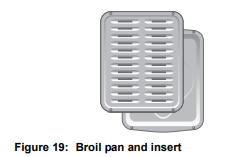
To set Broil
1. Arrange the oven rack while oven is still cool.
2. Press Broil. — — will appear in display.
3. Press for HI broil or for LO broil. Most foods may be broiled at the HI broil setting. Select the LO broil setting to avoid excess browning or drying of foods that should be cooked to the well-done stage.
4. For optimum results, preheat broil for 2 to 5 minutes before adding food.
5. If using a broil pan and insert, place insert on the broil pan. Place food on the insert
6. Place the broiler pan and insert on the oven rack.
7. Broil on one side until food is browned. Turn and broil food on other side.
8. When broiling is finished press OFF.
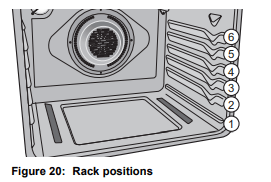
Table 2: Broil recommendations

The U.S. Department of Agriculture states, **Rare fresh beef is popular, but you should know that cooking it to only 140°F (60°C) means some food poisoning organisms may survive.” (Source: Safe Food Book, Your Kitchen Guide, USDA Rev. June 1985.) The lowest temperature recommended by the USDA is 145°F (63°C) for medium rare fresh beef. For well done 170°F (77ºC). All cook times shown are after 2 minutes of preheating.
Self Clean (models A and C)
A self cleaning oven cleans itself with temperatures well above normal cooking temperatures which eliminate soils completely or reduces them to a fine powdered ash you can wipe away with a damp cloth. While the oven is in operation, the oven heats to temperature much higher than those used in normal cooking. Sounds of metal expansion and contraction are normal. Oder is also normal because the food soil is being removed. Smoke may appear through the oven vent.
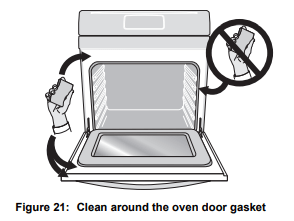
To set a self clean cycle or a delayed start self clean cycle:
1. Be sure the clock displays the correct time of day.
2. Press Start Time. The: in the time of day will flash.
3. Press and hold to scroll to the time to start the delayed self clean cycle. Release the key when the desired time is displayed.
to scroll to the time to start the delayed self clean cycle. Release the key when the desired time is displayed.
4. Press clean. --- appears in the display.
5. Press until 3:00 appears in the display for a 3 hour self clean process, or push
until 3:00 appears in the display for a 3 hour self clean process, or push  until 2:00 appears in the display for a 2 hour self clean process.
until 2:00 appears in the display for a 2 hour self clean process.
6. As soon as the controls are set, the motor driven lock will begin to close automatically and the door locked indicator light will flash. Do not open the oven door while the light is flashing (allow about 15 seconds for the oven door to lock).
7. CLn will appear in the display during the self clean cycle, and the door locked light will glow until the self cleaning cycle is complete or cancelled and the oven temperature has cooled.
When the self clean cycle has completed:
1. The time of day will appear in the display window, and the Self Clean indicator light and Door Locked light will continue to glow.
2. Once the oven has cooled down for about 1 hour and the Door Locked light has gone out, the oven door may be opened.
3. To avoid possible burns, use care when opening the oven door after the self cleaning cycle. Stand to the side of the oven when opening the door to allow hot air or steam to escape.
To stop or interrupt a self clean cycle (once it has been activated):
1. Press OFF.
2. Once the oven has cooled down for about 1 hour and the door locked light has turned off, the oven door can be opened.
3. Restart the self clean cycle once all conditions have been corrected.
Steam Clean (Model B)
The Steam Clean feature offers a chemical free and time saving method to assist in the routine cleaning of small and light soils.
Be sure the oven is level and cool before starting Steam Clean. If the oven temperature is above room temperature a triple beep will be heard and the function will not start. Steam Clean produces best results when started with a cool oven.
To set a Steam Clean cycle:
1. Remove all racks and oven accessories.
2. Scrape or wipe loose debris and grease from the oven bottom.
3. Pour 1 cup of tap water onto the oven bottom.(Figure 22) Close oven door.
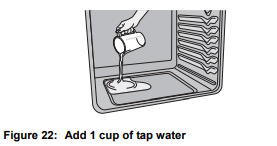
4. Press Steam Clean.
5. Press either the up arrow or down arrow to activate. St Cn will appear in the display.
6. The time remaining in the Steam Clean cycle is shown in the display. Do not open the door during this time. If door is open while in steam clean (d-O) will appear in the display.
7. When the steam clean cycle is complete an alert will sound and the END message will show in the display. Press OFF to return to the clock. Press OFF at any time to cancel Steam Clean.
8. Take care opening the door when the steam clean is finished. Stand to the side of the oven out of the way of escaping vapor.
9. Wipe oven cavity and bottom. Do not clean oven door gasket (Figure 23). Avoid leaning or resting on the oven door glass while cleaning cavity.
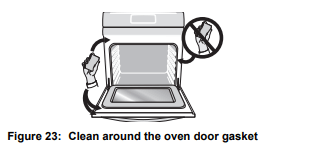
Notes:
- Opening the oven door during the steam clean cycle prevents the water from reaching the temperature needed to clean.
- For best results, clean oven immediately after the cycle is complete. Steam clean works best for soils on the oven bottom.
- A non-abrasive scouring pad, stainless steel sponge, plastic scraper, or eraser style cleaning pad (without cleaner) can be used for difficult soils. Moisten pads with water before use.
- Place a paper towel or cloth in front of the oven to capture any water that may spill out while wiping out.
- Do not leave the residual water in the oven for any length of time.
- Some condensation or water vapor may appear close to the oven vent and the oven door glass. This is normal. The oven gasket may become damp; do not wipe dry.
- Local water sources often contain minerals (hard water). If hard water deposits occur, wipe cavity with a 50/50 solution of water and vinegar or 50/50 solution of lemon juice and water.
- Steam clean cannot be programmed with a delayed start time
Adjusting the oven temperature
Your appliance has been factory calibrated and tested to ensure an accurate baking temperature. For the first few uses, follow your recipe times and temperature recommendations carefully. If you think the oven is cooking too hot or too cool for your recipe times, you can adjust the control so the oven cooks hotter or cooler than the temperature displayed.
To adjust oven temperature:
1. Press Bake.
2. Set the temperature to 550°F (288°C) by pressing and holding  .
.
3. Within 3 seconds, press and hold Bake until numeric digit(s) appear. Release Bake key. The display now indicates the amount of degrees offset between the original factory temperature setting and the current temperature setting. If the oven control has the original factory calibration, the display will read 00.
4. The temperature can now be adjusted up or down 35°F (19°C), in 5°F (or 1°C) increments.
5. Press and hold  to adjust the temperature higher until the desired amount of offset appears in the display. When lowering the oven temperature using
to adjust the temperature higher until the desired amount of offset appears in the display. When lowering the oven temperature using , a minus sign (-) will appear before the number to indicate that the oven will be cooler by the displayed amount of degrees.
, a minus sign (-) will appear before the number to indicate that the oven will be cooler by the displayed amount of degrees.
6. When you have made the desired adjustment, press OFF to go back to the time of day display.
Remove spills and any heavy soiling as soon as possible. Regular cleaning will reduce the difficulty of major cleaning later.
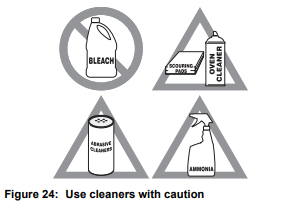
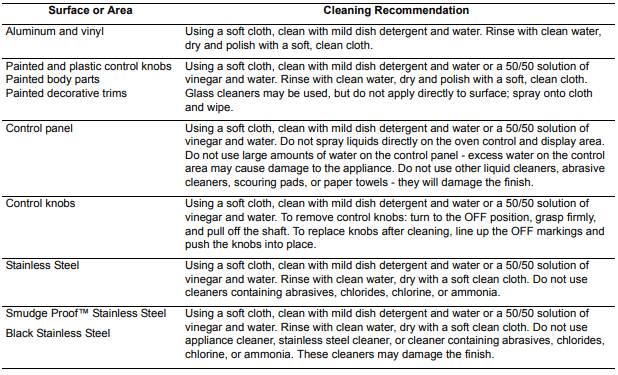
CARE AND CLEANING
Aluminum Foil and Utensils
To avoid possible burns, do not attempt cleaning before turning off all surface burners and allowing them to cool. Any additions, changes, or conversions required in order for this appliance to satisfactorily meet the application needs must be made by an authorized qualified Agency. Routinely clean the cooktop. Wipe with a clean, damp cloth and wipe dry to avoid scratches. Keeping the surface burner head ports and slots clean will prevent improper ignition and an uneven flame.
To clean recessed and contoured areas of cooktop:
- If a spill occurs on or in the recessed or contoured areas, blot up spill with an absorbent cloth.
- Rinse with a clean, damp cloth and wipe dry
To clean burner heads:
1. Remove the burner cap from the burner head (see Figure 25). Clean the cap with hot soapy water and dry thoroughly
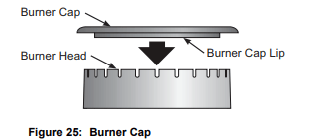
2. For burned-on and dried spills, apply hot soapy water to the burner head. Allow time for the soils to soften.
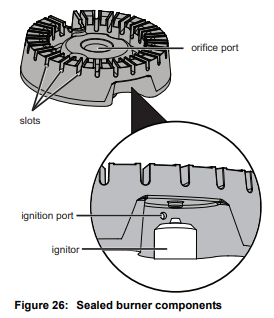
3. Use a toothbrush to clean all over the burner head (see Figure 26).
4. Use the toothbrush to clean the slots and holes in the burner (see Figure 26).
5. Use a needle or fine wire to clean out the ignition port (see Figure 26).
6. Wipe the burner head clean with a soft, clean cloth, sponge, or scratch-free cleaning pad.
7. Before using the cooktop again, make sure the burner caps are properly placed and seated on the burner heads. When placed correctly, the burner cap is centered on the burner head and will click into place on the burner head. You can wiggle the cap to test placement, it should not move off the burner head (see “Assembly of the burner caps” on page 13).
Important notes:
- The surface burner heads are secured to the cooktop and must be cleaned in place on the cooktop.
- Always keep the surface burner caps in place whenever a surface burner is in use.
- When replacing the burner caps, be sure the burner caps are seated firmly on top of the burner heads.
- For proper flow of gas and ignition of burners do not allow spills, food, cleaning agents, or any other material to enter the gas orifice port opening.
Replacing the Oven Light
Replacing the oven interior light bulb:
The interior oven light is located at the rear of the oven cavity and covered with a glass shield. The glass shield must be in place whenever the oven is in use (Figure 27).
1. Turn electrical power off at the main source or unplug the appliance.
2. Remove the interior oven light shield after removing the wire holder by carefully moving the wire to the side of the glass shield. The tension from the wire holds the glass shield in place.
3. Pull the shield straight out. Do not twist or turn.
4. Replace the bulb with a new appliance bulb.
5. Replace the glass oven light shield. Replace wire holder.
6. Turn the power back on again at the main source (or plug the appliance back in)
7. Be sure to reset the time of day on the clock.
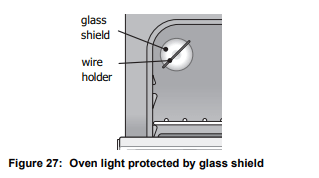
To remove and replace storage drawer (some models)
Use the storage drawer for storing cooking utensils. The drawer can be removed to facilitate cleaning under the range. Use care when handling the drawer.
To remove the drawer:
1. Pull empty drawer out until it stops.
2. Tilt up the front of the drawer up and pull it out over the glide stop.
To replace the drawer:
1. Insert the back of the drawer into the opening.
2. Lift up the drawer and line up the drawer supports with the rails. Make sure to clear the glide stop.
3. Push in the drawer until it stops.
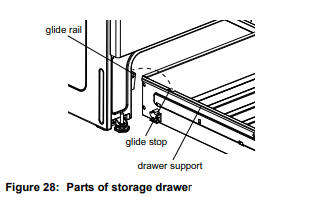
Removing and Replacing the Oven Door
To remove oven door:
1. Open oven door completely, horizontal with floor (See Figure 29).
2. Pull the door hinge locks on both left and right door hinges down from the oven frame completely towards the oven door (See Figure 30). A tool such as a small flat-blade screwdriver may be required.
3. Firmly grasp both sides of oven door along the door sides. Do not use the oven door handle (See Figure 31).
4. Close the door to approximately 10 degrees from the door frame (See Figure 31).
5. Lift the oven door hinge arms over the roller pins located on each side of the oven frame (See Figure 32).
To replace oven door:
1. Firmly grasp both sides of oven door along the door sides. Do not use the oven door handle (See Figure 31).
2. Holding the oven door at the same angle as the removal position, seat the hook of the hinge arm over the roller pins located on each side of the oven door frame (See Figure 31 and Figure 32). The hook of the hinge arms must be fully seated onto the roller pins.
3. Fully open the oven door, horizontal with floor (See Figure 29).
4. Push the door hinge locks up towards and into the oven frame on both left and right oven door hinges to the locked position (See Figure 30).
5. Close the oven door.
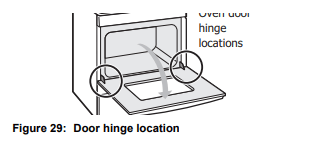
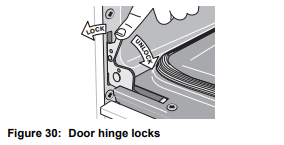
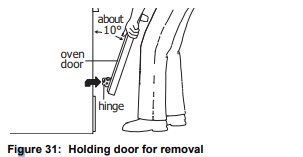
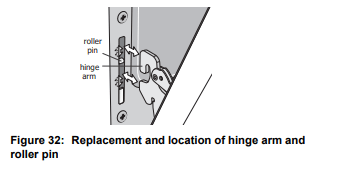
BEFORE YOU CALL
Oven Baking
For best cooking results, preheat the oven before baking cookies, breads, cakes, pies, pastries, etc. There is no need to preheat the oven for roasting meat or baking casseroles. The cooking times and temperatures needed to bake a product may vary slightly from your previously owned appliance.

Solutions to Common Problems:
Before you call for service, review the following list. It may save you time and expense. Possible solutions are provided with the problem listed
- Entire appliance does not operate.
- Appliance not connected. Make sure power cord is plugged properly into outlet. Check your fuse box or breaker box to make sure the circuit is active. Electrical power outage. Check house lights to be sure. Call your local electric company for service outage information.
Oven Problems
- Poor baking results.
- Many factors affect baking results. Use proper oven rack position. Center food in the oven and space pans to allow air to circulate. Preheat the oven to the set temperature before placing food in the oven. Try adjusting the recipe's recommended temperature or baking time. See “Adjusting the oven temperature” on page 32 if you feel the oven is too hot or too cool.
- Flames inside oven or smoking from oven ven
- Excessive spills in oven. Grease or food spilled onto the oven bottom or oven cavity. Wipe up excessive spills before starting the oven. If flames or excessive smoke are present when using broil, see “Setting Broil” on page 27.
- Oven smokes excessively when broiling.
- Incorrect setting. Follow the “Setting Broil” instructions on page 27. Meat too close to the broil element or burner. Reposition the broil pan to provide proper clearance between the meat and broil element or burner. Remove excess fat from meat. Cut remaining fatty edges to prevent curling, but do not cut into lean. Grease build up on oven surfaces. Regular cleaning is necessary when broiling frequently. Grease or food splatters will cause excessive smoking.
- Oven control panel beeps and displays any F or E code error.
- Oven control has detected a fault or error condition. To clear the error, press the OFF key on the control panel. Once the error code is cleared, try the bake or broil function. If the F or E code error repeats, turn off the power to appliance, wait 5 minutes, and then repower the appliance. Set the clock with correct time of day. Try the bake or broil function again. If the fault recurs, press the OFF key to clear.
- Oven portion of appliance does not operate.
- Be sure the regulator gas valve is turned to ON. See installation instructions. The time of day is not set. The clock must be set in order to operate the oven. See “Setting the Clock” on page 22. Be sure the oven controls are set properly for the desired function. See “Setting Oven Controls” starting on page 20 and review instructions for the desired cooking function in this manual or see “Entire appliance does not operate.” in this checklist.
Cooktop Problems
- Surface burners do not ignite.
- Surface control knob was not completely turned to LITE
 . Push in and turn the surface control knob to LITE until the burner ignites and then turn the control knob to the desired flame size. Burner ports are clogged. With the burner OFF and cool, use a small-gauge wire or needle to clean the burner head slots and ignition ports. See“Cleaning the sealed burners” in the Care & Cleaning section on page 35 for additional cleaning instructions. Range power cord is disconnected from outlet (electric ignition models only). Be sure the power cord is securely plugged into the power outlet. Circuit is broken. Check breaker box or fuse box. Electrical power outage. Burners may be lit manually. See “Setting surface controls” on page 16.
. Push in and turn the surface control knob to LITE until the burner ignites and then turn the control knob to the desired flame size. Burner ports are clogged. With the burner OFF and cool, use a small-gauge wire or needle to clean the burner head slots and ignition ports. See“Cleaning the sealed burners” in the Care & Cleaning section on page 35 for additional cleaning instructions. Range power cord is disconnected from outlet (electric ignition models only). Be sure the power cord is securely plugged into the power outlet. Circuit is broken. Check breaker box or fuse box. Electrical power outage. Burners may be lit manually. See “Setting surface controls” on page 16.
- Surface control knob was not completely turned to LITE
- Surface burner flame uneven or only part way around burner cap.
- Burner slots or ports are clogged. With the surface burner OFF and cool, clean ports with a small-gauge wire or needle. If moisture is present after cleaning, lightly fan the flame and allow the burner to operate until flame is full. Burner caps are not seated properly. Check that all burner caps are level and seated correctly on the burner heads. See“Cleaning the sealed burners” in the Care & Cleaning section on page 35 for additional cleaning instructions.
- Surface burner flame is too high.
- Surface control knob is set too high. Adjust to a lower flame setting. Burner caps are not seated properly. Check that all surface burner caps are level and seated correctly on the surface burner heads. See“Cleaning the sealed burners” in the Care & Cleaning section on page 35 for additional cleaning instructions. Incorrect L.P. conversion. Refer to L.P. conversion kit instructions to correct.
- Surface burner flame is orange.
- Dust particles in main gas line. Allow the burner to operate a few minutes until flame turns blue. In coastal areas, a slightly orange flame is unavoidable due to salt content in the air. Incorrect L.P. conversion. Refer to L.P. conversion kit instructions to correct.
Self Clean Problems
- Self clean does not work.
- Oven control not set properly. See “Self Clean (models A and C)” on page 29.
- Oven racks discolored or do not slide easily.
- Oven racks left in oven cavity during self clean. Remove oven racks from oven cavity before starting a self-clean cycle. Clean by using a mild abrasive cleaner following manufacturer's instructions. Rinse with clean water, dry, and replace in oven.
- Soil not completely removed after self clean.
- Self clean was interrupted. Review instructions on “Self Clean (models A and C)” on page 29. Excessive spills on oven bottom. Remove excessive spills before starting self clean. Failure to clean soil from the oven frame, the door liner outside the oven door gasket, and the small area at the front center of the oven bottom. These areas are not in the self-cleaning area, but get hot enough to burn on residue. Clean these areas before starting the self-cleaning cycle. Burned-on residue can be cleaned with a stiff nylon brush and water or a nylon scrubber. Be careful not to damage the oven gasket.
- The oven control display shows "SPr" and self-clean is not working.
- The cooktop should not be used during a self-clean cycle. On some models, turning on any cooktop surface burner will cause the clean cycle to cancel. If the clean cycle is canceled, the oven control display will show “SPr" for 5 seconds. The oven door will remain locked until the oven has cooled down below cleaning temperature. If the oven is below cleaning temperature, the user can start another clean cycle immediately. If the oven is in cleaning temperature range, another self-clean cycle can be set once the door unlocks (up to 4 hours).
Other Problems
- Appliance is not level.
- Be sure the floor is level, strong, and stable enough to adequately support the range. If the floor is sagging or sloping, contact a carpenter to correct the situation. Poor installation. Place the oven rack in the center of the oven. Place a level on the oven rack. Adjust the leveling legs at the base of the appliance until the rack is level. Kitchen cabinet alignment may make range appear not level. Be sure cabinets are square and have sufficient room for appliance clearance
- Cannot move appliance easily. Appliance must be accessible for service.
- Cabinets not square or are built in too tightly. Contact the builder or installer to make the appliance accessible. Carpet interferes with appliance. Provide sufficient space so the appliance can be lifted over carpet. Installation over carpet is not advised. See the installation instructions for guidelines specific to your appliance.
- Oven light does not work.
- Be sure the oven light is secure in the socket. See “Replacing the Oven Light” on page 36.
See other models: FFRE123ZA1 FTMD18P4TD FDB1050RES FFTR1222QM FFRE223WAE

